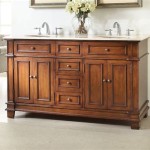How to Measure a Bathroom Vanity Sink With Cabinet
Choosing the right bathroom vanity can be a daunting task, as it involves various factors such as size, style, and functionality. Accurately measuring the space for your vanity is crucial to ensure a perfect fit and avoid any potential issues during installation. This article provides a comprehensive guide to measuring a bathroom vanity sink with cabinet, outlining essential steps and considerations.
1. Determine the Available Space
The first step is to determine the precise dimensions of the available space for your vanity. This involves measuring the width, depth, and height of the area where the vanity will be installed. It's crucial to consider any obstructions such as pipes, vents, or electrical outlets that might affect the available space. Use a measuring tape to measure the width of the wall where the vanity will be placed, ensuring you account for any unevenness or protrusions.
Next, measure the depth of the area, taking into account any existing fixtures or appliances that may be in close proximity. Remember to consider the space required for the vanity doors to open freely. You can use a pencil to mark the floor and wall, indicating the maximum width and depth of the vanity. Finally, measure the height of the available space from the floor to the ceiling, accounting for any potential obstructions such as light fixtures or cabinets.
2. Measure the Existing Vanity (If Applicable)
If you are replacing an existing vanity, it's essential to measure its dimensions to ensure the new one will fit comfortably. Measure the width, depth, and height of the existing vanity. You can also measure the distance between the countertop and the floor, which will be helpful in determining the required height of your new vanity.
Note that the height of the vanity may not be exactly the same as the height of the countertop, as there are varying countertop thicknesses available. Additionally, consider the height of the faucet and how it will affect the overall height of the vanity when measuring the height.
3. Consider Overall Space Layout
Once you have the measurements for the available space and the existing vanity (if applicable), it's important to visualize the overall layout of the bathroom. Consider the placement of other fixtures such as the toilet, shower, and bathtub. Ensure there is enough space for the vanity to be installed without obstructing the flow of movement within the bathroom.
You should also consider the placement of the plumbing lines. Check the location of the existing drain pipe and water supply lines to ensure they align with the position of the new vanity. You can use a level and a plumb bob to accurately determine the location of the drain and supply lines for proper installation.
4. Measure Sink and Cabinet Separately
After measuring the available space, it's essential to measure the sink and cabinet separately. Check the width, depth, and height of the sink itself. If you're purchasing a pre-made vanity, you can measure the sink before making your purchase. However, if you're purchasing a separate sink and cabinet, it's essential to ensure that the sink fits within the cabinet.
When measuring the cabinet, ensure it fits within the allocated space. Consider the overall width, depth, and height of the cabinet. Also, check the dimensions of the doors and drawers to ensure they open and close freely without hitting any obstructions. When measuring the cabinet, consider the thickness of the countertop as it will add to the overall height of the vanity.
5. Account for Installation Considerations
Finally, it's important to consider installation considerations when measuring your bathroom vanity. You must account for the thickness of the wall and any trim or molding around the vanity. Ensure there is sufficient clearance for installation and accessibility for plumbing and electrical work. If you are installing a new vanity with different plumbing connections, you should consider the feasibility of adjusting the existing plumbing or hiring a professional plumber to make the necessary modifications.
Additionally, consider the accessibility of the location for installation. Ensure you have adequate access to the area for the installation crew to bring in the vanity, remove any old vanity, and connect the plumbing and electrical fixtures.
By following these steps and considering the various factors outlined above, you can ensure you choose the right-sized bathroom vanity for your space. Accurately measuring the available space, the existing vanity, and the sink and cabinet ensures a perfect fit and a smooth installation process. Remember that it's always advisable to consult with a professional if you have any doubts or are unsure about specific measurements or installation procedures.

How To Choose The Right Vanity For Your Bathroom Riverbend Home

What S The Standard Depth Of A Bathroom Vanity
How To Measure A Vanity Sink Bathroom Dimensions Standard Size Vevano

What Is The Standard Bathroom Vanity Height Size Guide

How To Measure For A Bathroom Vanity The Home Depot
How To Measure A Vanity Sink Bathroom Dimensions Standard Size Vevano

How To Measure For A Bathroom Vanity The Home Depot

How To Choose Your Bathroom Vanity Height
How To Measure A Vanity Sink Bathroom Dimensions Standard Size Vevano

Bathroom Vanity Sizes 4 Steps To Find The Best Fit For Your Space
Related Posts







